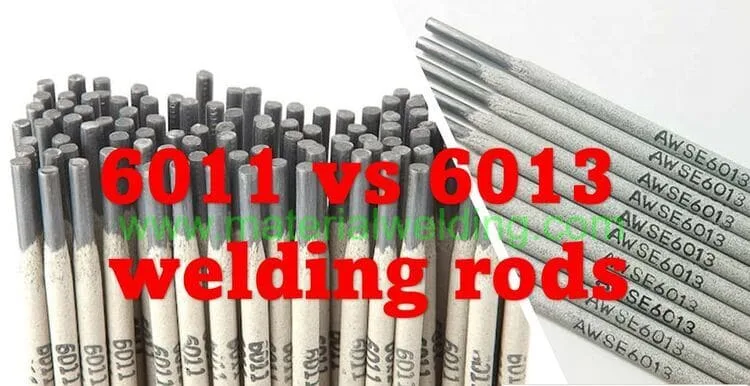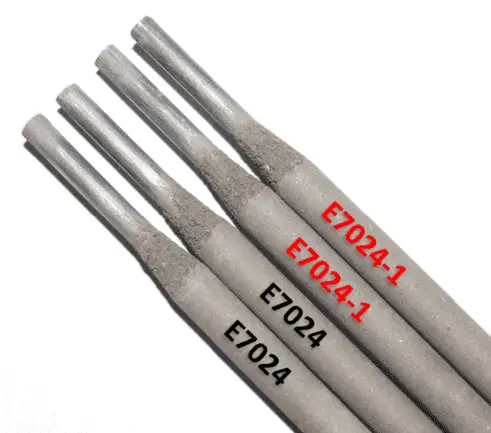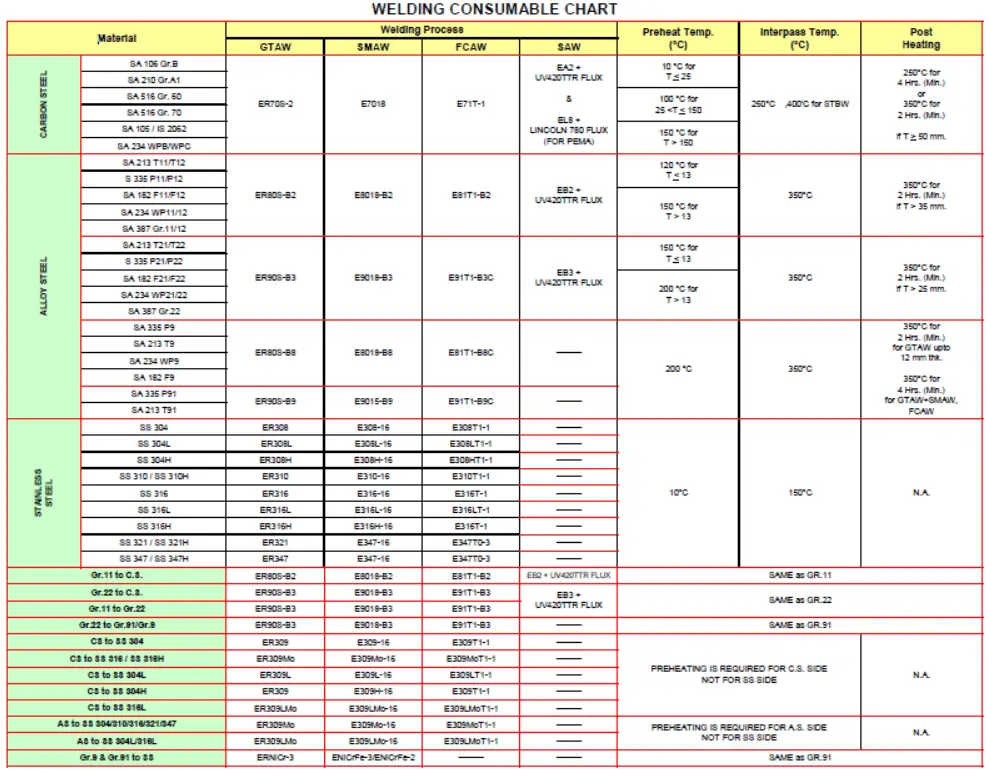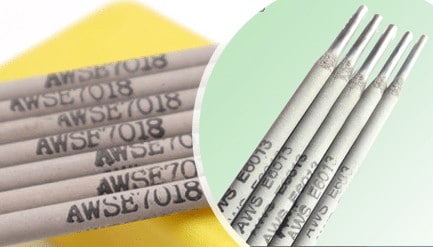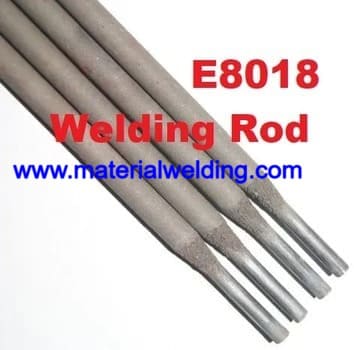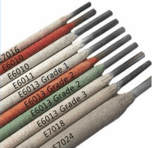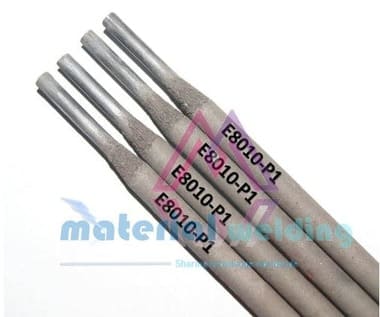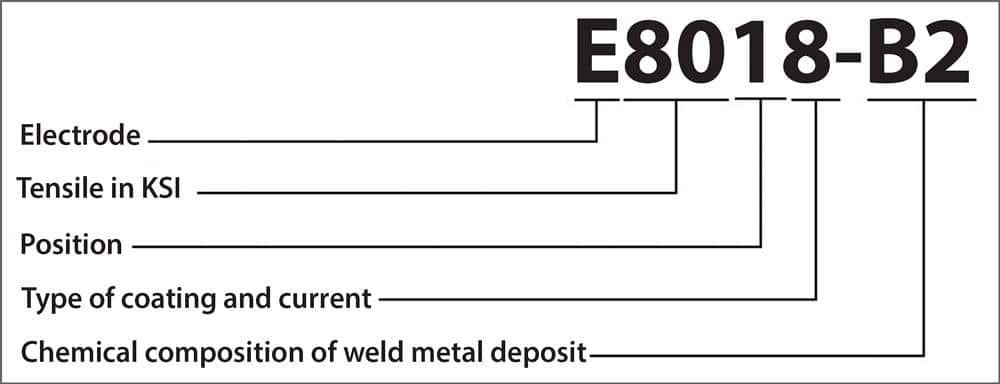Explore the world of welding electrode types and understand the meaning and classification of welding rod numbers. Gain valuable insights into the different types of electrodes, their applications, and the significance of electrode numbering systems. Discover comprehensive information, practical examples, and expert guidance to enhance your understanding of welding electrodes and make informed choices for your welding task.
In Stick Welding there are a number of Welding Electrode types to weld different materials, varied purposes and welding rod characteristics. So what are the main types of welding electrodes?
Let us learn in depth with this post.
Stick Welding Electrode Types: Classification, & coating types
Stick welding (SMAW) electrodes are an important part of the welding process. They come in a variety of metallurgy and sizes, and each one has its own specific purpose. There are also many different types of stick welding electrodes, so it’s important to choose the right one for the job.
Some common stick welding (SMAW) Welding Electrodes Types (Welding Rod Types) include:
- General-purpose electrodes (for mild steel) such as E6010, E6011, and E6013.
- Low hydrogen electrodes (For Carbon Steel & low alloy steel Welding) E.g., E7018, E8018, & E10018.
- Stainless Steel Electrode (for stainless steel and other high-quality metals) E.g., E308L, E309l.
- Cast Iron welding (For Cast Iron & cast iron to carbon steel) E.g., ENiFe-CI, ENi.
- And many more types.
When choosing a stick welding electrode, it’s important to consider the thickness and type of metal being welded, as well as the environment in which the weld will take place.
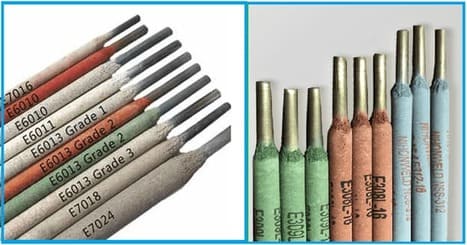
SMAW Welding or stick welding Electrodes Types are classified based on the following factors:
- Size –The commonly available sizes are 3/32, 1/8 (commonest), 5/32, and 3/16, 7/32, ¼ and 5/16 inches (2.4, 2.5, 3.2, 4.0, 4.8, 5.0, 5.6, 6.0, 6.4 & 8.0 millimeter).
- Type of current: AC, DC (DCEP/ DCEN)
- Type of covering: Cellulose, rutile, acid, basic, iron powder, etc. as explained in detail in this article.
- Material –The stick welding electrodes come in mild steel, iron-free, high carbon steel, cast iron, stainless steel, and special alloy.
- Strength –The tensile strength of the weld needs to be stronger than the metal being welded. The material in the electrode needs to be stronger as well to accommodate the weld dilution happening due to electrode coating/ base metal.
- Welding position –The different electrodes used for each welding position as horizontal, flat, vertical, overhead as given in figure 1, etc. Watch this YouTube Video to learn about different welding positions.
4 Types of Welding Electrodes & Rods
The mainly used 4 types of Welding Electrodes for Mild Steel & Carbon Steel Welding are:
- E6010
- E6013
- E7018 &
- E7024
Following are the main welding rod types for stainless steel welding:
- E308L-16
- E309L-16
- E316L-16
- E310-16
- E347-16
What are the Stick Welding Rod Coating Elements:
The Main Elements in Stick Welding Rod Coating are:
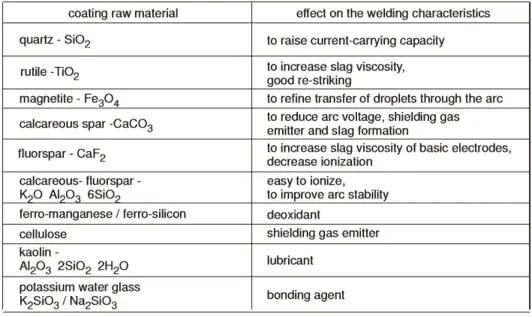
1) Fluxing agents: Silica, CaO (from limestone), Fluorspar.
2) Slag-formers: Rutile, Titania, Potassium titanate, Ilmenite, Asbestos, Alumina, Silica flour, Iron powder, Fluorspar, Feldspar, Man4anese dioxide, Wollastonite.
3) Arc stabilizers: Potassium oxalate, Potassium silicate, Zirconium carbonate, Potash, feldspar, Lithium carbonate, Titania.
4) Gas-forming materials: Cellulose, Limestone, Wood flour.
5) Slipping agents (for easy extrusion): Glycerin, China clay, Kaolin clay, Talc, Bentonite, clay, Mica.
6) Binding agents: Sodium silicate, Dextrin, Potassium silicate, Gum, Sugar, Asbestos.
7) Deoxidizers and alloying elements: Ferrotitanium, Ferrosilicon, Ferrochromium, Ferro-columbium, Ferromanganese, Electro-nickel, Electro-manganese, Ferromolybdenum, Metals in powdered form.
Stick Welding (SMAW) Rod Core Wire Material
It is preferred to semi-killed or fully-killed steel because it is cheaper to produce and also because it confers optimum performance characteristics on the electrode.
Since it is possible to obtain any desired alloy steel chemistry of the weld metal by incorporating suitable alloying elements in the flux coating, the modern electrode producer uses a single grade of semi-killed quality steel to manufacture a wide range of mild steel, low-alloy steel and hardfacing electrodes.
American Welding Society’s Specification for Carbon Steel Covered Arc Welding Electrodes (AWS A5.1) states: “The core wire used for the welding rod in this specification is usually a semi-killed or capped steel having usually 0.10% carbon (C), 0.45% Mn, 0.03% Sulphur, 0.02% phosphorus, & 0.01% silicon.”
Core wire is an important component of a manual electrode, because it significantly influences the electrode performance and weld metal properties. semi-killed quality steel is specified and used for making core wire of mild steel electrodes all over the world.
The general chemistry of a carbon steel welding electrode core wire is listed below:
Carbon 0.10 max.
Silicon 0.03 max.
Manganese 0.38 to 0.62
Sulfur 0.030 max.
Phosphorus 0.030 max.
Copper 0.15 max.
Stick Welding (SMAW) Electrode Coating Functions
Stick Welding (SMAW) Electrode Coating main Functions or objectives are listed below:
- It generates gases that displace the oxygen and nitrogen of the atmosphere and provide a gaseous shield around the arc to protect the molten droplets during their passage across the arc as well as the molten weld puddle.
- It produces slag which further protects the molten droplets in the arc and the molten weld puddle from atmospheric attack, and also provides an insulating blanket over the weld bead.
- It helps to deoxidize and refine the weld metal.
- It helps to modify the chemistry by providing alloying elements for the weld metal, either by reducing metallic oxides or by means of powdered Ferro-alloys and metals. Thereby the mechanical properties of the weld metal are also suitably modified.
- It helps to control the weld bead profile and to obtain a smooth weld surface with even ripples.
- It helps to reduce weld spatter.
- It insulates the electrode so that it can operate at a sufficiently high current without getting overheated.
- It makes vertical and overhead welding possible by controlling the viscosity of the slag.
- It influences the operating characteristics of the electrode and, to some extent, its burn-off rate and the depth of penetration of the weld bead into the base metal.
- The coating has a low thermal conductivity, and melts slower than the core wire. Thus, in the case of heavy-coated electrodes, the coating forms a cup around the upper portion of the arc and prevents air from being drawn into the arc stream. The cup formation also makes touch or contact welding possible.
- The coating increases deposition efficiency and weld metal deposition rate through iron powder and ferro-alloy additions.
The coating also controls the following arc characteristics:
- Arc voltage and current intensity.
- Thermal and dynamic energy.
- The feasibility of welding with DC or AC, and electrode polarity in DC.
- Process of emission and ionization.
- Mode of metal transfer: short-circuiting, free flight, spray type.
Most common SMAW Welding Rod Types & Numbers
E6010 Stick Welding (SMAW) Welding Rod
E6010 is a cellulose-based stick welding rod used for pipeline root run welding. Click here to learn in details about E6010 Rod meaning, specification, properties, polarity, and test certificate.
E6010 Electrode Specification & its meaning
E6011 Stick Welding (SMAW) Welding Rod
E6011 or E4311 is a carbon steel (mild steel) welding rod for stick welding. E6011 [E4311 as per CSA W48] electrodes are designed to be used with AC current polarity and to copy the rod usability characteristics & mechanical characteristics of the rod type of E6010 [E4310] classification.
E6011 can also be used in reverse polarity (DCEP). E6011 gives less penetration compared to rod type of E6010 (E4310).
E6011(E4311) Welding electrode meaning & specification
E6012 Stick Welding (SMAW) Welding Rod
E6012 are high titania/ rutile type coating producing thick slag and low welding penetration. They are good for welding sheet metal work.
E6012 rods can be used for welding position welding. The weld of E6012 is less ductile compared to E601 type rod.
Related reading: E6012 Welding Rod: Everything you need to know.
E6013 Stick Welding (SMAW) Welding Rod
SMAW/ Stick electrode E6013 as per AWS SFA 5.1 or E4313 as per SFA 5.1M or CSA W48 is the most widely used stick welding electrodes for sheet metal, general fabrication & structural welding work.
E6013 (CSA E4313) electrodes are very similar to the E6012 (CSA E4312) electrodes but E6013 is having distinct differences in the coating, slag formation & welding polarity.
Click the below link to learn about the E6013 stick welding rod in detail.
E6013 Electrode Specification & its meaning, actual MTC
E7018 Stick Welding (SMAW) Welding Rod
E7018 is a low hydrogen stick welding rod used for welding mild steel and carbon steel. It is also used for welding carbon steel material to low alloy steel and cast steel welding.
Click the below link to learn about the E7018 stick welding rod in detail.
E7018 Electrode Specification & its meaning, E7018 MTC.pdf
E7024 Stick Welding (SMAW) Welding Rod
E7014 or E4914 stick welding rods have a coating type (rutile base) like E6012 & E6013 type welding rods. But E7024 is added with additional iron powder to increase the welding deposition efficiency.
E7024 has a heavier coating & extra iron powder added to it compared to the E7014 type welding rod. Although, this rod can not be used in all position welding like the E7014 type.
Click the below link to learn about the E7024 stick welding rod in detail.
E7024, E7024-1 Electrode Specification & its meaning
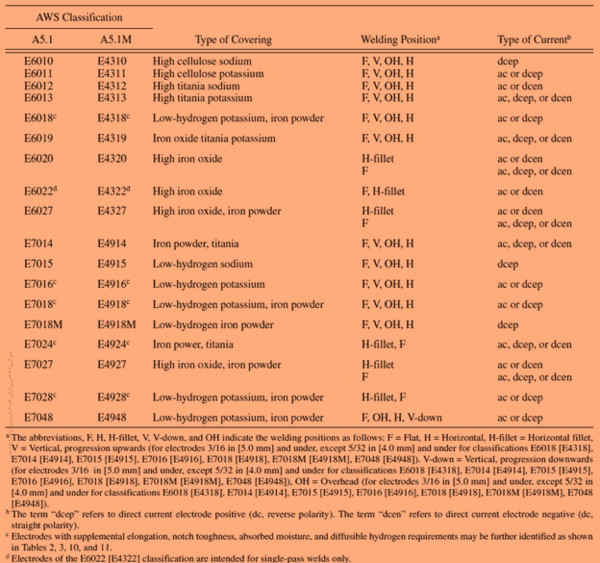
Types of Welding Electrode Coating & their various functions
The coating of Stick Welding or SMAW Welding rods contains different elements to serve various combined purposes required for a successful welding operation.
The main coating elements in a welding electrode are:
- Cellulose – The main element of cellulose electrodes (E6010, E7010) burns and generates gases (mainly CO2) to provide shielding to the weld puddle to prevent weld oxidation.
- Metal carbonates– are used to give basicity to the weld slag and are mainly used in low hydrogen electrodes such as the E7018 type.
- Titanium dioxide– Titanium dioxide is beneficial to giving fluidity to the weld and making weld slag fast freezing. It helps in the arc stabilization by giving ionization to the welding arc.
- Ferro-manganese and ferrosilicon– Ferroalloys are added to the coating to provide additional silicon and manganese that might be lost from the weld deposit due to deoxidation during welding. They also help to eliminate the adverse effects of Sulphur and phosphorus.
- Binding agents – Binding agents help to hold the coating intact on the mild steel wire by giving coating strength as well as providing a good mixing of other elements present in the electrode coating.
- Mineral silicate– Silicate of various mineral melt during welding and form weld slag that helps in the slow cooling of the weld as well as protect the hot weld metal from adverse oxidation effect until the weld cools.
- Calcium fluoride– Calcium fluoride is added in the basic & rutile electrodes to provide the shielding gases, weld fluidity, and slag basicity.
- Alloying elements as Ni, Cr, Mo, Nb– Additional alloying elements are added to the weld metal by mixing the powdered alloying element in the electrode coating. During the melting of the weld electrode, the alloying elements melt and become part of the solidified weld metal.
- Manganese or iron oxide– These elements work as arc stabilizers and improve slag-forming properties.
- Iron powder– Iron powder is added to the coating to increase the electrode deposition efficiency. Powdered iron is added to the electrode coating that melts during the weld and becomes part of the weld. Same time, with the same core wire diameter, and added iron powder electrode deposition efficiency is higher compared to one without added iron powder.
SMAW Electrode Coating types for Mild Steel
The main type of Stick Welding or SMAW electrode coating are:
1) Cellulosic type
2) Rutile type
3) Acid type
4) Acid rutile type
5) Oxidizing type
6) Basic type
7) Cellulosic Type
Here, the most common Welding electrodes Types & Coating used in AWS Specification Stick Welding Rods are explained.
Cellulose Sodium Coating (EXX10 type rods)
The major constituent of this covering is cellulose, generally more than 30% by weight. Other organic materials such as woodflour, charcoal, cotton, yarn, paper wrappings, starches, and gums have also been used to replace cellulose partially.
The other elements usually used are titanium dioxide (derived from the granular mineral rutile), metallic deoxidizer e.g. ferromanganese, different types of aluminum or magnesium silicates, & silicate liquid sodium to bind coating elements.
The cellulose, which is an organic material, decomposes in the arc and produces a voluminous gas shield that protects the arc from atmospheric oxygen and nitrogen.
The gaseous atmosphere produced at the arc has approximately the following composition:
1.0% CO2, 55% CO, 42% H2 and 1.5% H2O.
The amount of slag produced is relatively small. The weld deposit is thus covered with a thin, friable slag layer, which is easily detachable. This covering type does not have enough ionizing compounds and hence the electrode having this covering operates only on DC.
For use on AC (as well as DC), small quantities of compounds of calcium & potassium are added to the covering and the sodium silicate binder is replaced by potassium silicate. A special feature of this type is that 4 to 6% moisture is deliberately retained in the coating as it contributes favorably to the operating characteristics of the electrode.
The moisture prevents premature charring of the cellulose and results in a deeply penetrating, forceful, spray-type arc, which is used to advantage in the so-called stovepipe welding of cross-country pipelines.
Rutile Type Coating Rods (EXX13, EXX14 types)
The major constituent of this covering is rutile, usually exceeding 50% by weight (not taking into account cellulosic material). Rutile is naturally-occurring sand, containing around 95% of titanium dioxide.
It has a natural dark-black, shining appearance, unlike pure titanium dioxide (called titania), which is snow-white and is therefore also termed titanium white. Rutile is sometimes used in the covering in a finely ground form which has a dirt-brown color.
The covering also contains slag-forming silicious materials like feldspar and china clay, and calcium and potassium compounds to ensure arc stability in AC welding. Cellulose and ferromanganese in varying amounts are also included. The binder is sodium silicate or potassium silicate.
Two distinct versions of this type have emerged over the years. One of them contains 10 to 15% cellulose and is applied to the electrode to give a coating factor of 1.3 to 1.4.
The slag formed during welding is viscous and quick-freezing, and this renders the electrode particularly used for vertical welding and overhead positions. The electrode with this covering is the most popular type in most countries and is described as the general-purpose mild steel structural electrode.
The other version contains around 3% cellulose and is applied to the electrode to give a coating factor of 1.5 to 1.7. The slag formed during welding is heavy, compact, and usually self-detaching.
Acid Type Coating rods
The major constituent of this covering is iron oxide. Other constituents are manganese compounds (sometimes including manganese oxide) and silica along with sufficient deoxidizers.
Organic materials are absent. Potassium silicate is used as a binder. During welding, this covering produces a voluminous iron-manganese oxide-silica fluid slag, whose metallurgical character is acidic. This slag solidifies in a characteristic honeycomb structure and is easily detached.
Basic Type Coating rods (EXX18)
This covering has a high content of calcium carbonate (in the form of limestone, calcite, or marble) and calcium fluoride (in the form of fluorspar).
This results in a chemically basic slag, which is fairly fluid. The solidified slag, which is heavy and friable has a brown to dark-brown color and a glossy appearance.
The use of organic materials like cellulose and minerals with chemically combined water is avoided in order to keep the arc hydrogen-free. The gaseous atmosphere created by these electrodes in the arc consists of CO, CO2, and F Compounds.
Reading: Welding Electrode Types/ Welding Rod Types/ Electrode Classification
